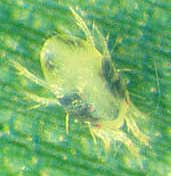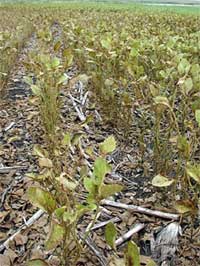|
Iowa State
University specialists report on infestation of spider mites and
soybean aphids in Iowa soybean fields |
Ames, Iowa
July 15, 2005
 The hot, dry weather conditions are increasing the need for
producers to scout their fields. Reports to
Iowa State University
(ISU) crop specialists indicate infestations of spider mites
(photo*)
in some Iowa soybean fields, as well as isolated fields with
more than 250 soybean aphids per plant. The hot, dry weather conditions are increasing the need for
producers to scout their fields. Reports to
Iowa State University
(ISU) crop specialists indicate infestations of spider mites
(photo*)
in some Iowa soybean fields, as well as isolated fields with
more than 250 soybean aphids per plant.
Its unclear right now how serious the aphid threat will be
this year. Data collected by Brian Lang, ISU Extension field
crop specialist in northeast Iowa, show fewer aphids per
plant this year than in 2003, but more aphids per plant than
were found in 2004.
Reports of spider mite infestations are primarily from
eastern Iowa, which has had drier conditions than the rest
of the state this crop season.
"Growers should be aware of the similarities and differences
between these two pests, and adjust their management plans
accordingly," said Matt O'Neal, assistant professor,
Entomology.
"Two spotted spider mites (Tetranychus urticae) and
soybean aphids (Aphis glycines) both feed on soybean
leaves, but have very little else in common," he said.
 "Mite damage results in the leaf changing colors to yellow
and the leaf surface curling (photo*). During heavy spider mite
infestations leaves will drop off the plant. Aphid feeding
does not result in the leaf turning yellow. Heavy aphid
infestations can change the color of leaves, with leaves
looking dark gray or even black. This is due to honeydew (a
sugary, sticky substance excreted by aphids) that is
infested with sooty mold." "Mite damage results in the leaf changing colors to yellow
and the leaf surface curling (photo*). During heavy spider mite
infestations leaves will drop off the plant. Aphid feeding
does not result in the leaf turning yellow. Heavy aphid
infestations can change the color of leaves, with leaves
looking dark gray or even black. This is due to honeydew (a
sugary, sticky substance excreted by aphids) that is
infested with sooty mold."
Although spider mites and aphids are small, they are capable
of moving great distances. Mites are readily blown by wind,
so initial colonization often occurs in the direction of
prevailing winds. Landscape features that disrupt airflow,
(tree lines, houses, or even telephone poles) can help
spider mite populations establish. Cool, humid conditions
promote growth of fungal diseases that prevent spider mite
outbreaks.
O'Neal says infestations of spider mites and aphids can
begin in spotty, isolated areas of a soybean field. However,
under certain conditions both pests can spread across large
areas. For example in 2003, nearly 3 million acres were
treated for soybean aphids in Iowa. During 1988, nearly 3
million acres were treated for spider mites. Spider mite
infestations typically occur on field perimeters and can
eventually spread throughout a field. Scouting for both
pests will require surveying both field edges and interior.
"Growers scouting for aphids need to make the extra effort
to survey the entire field, looking for symptoms of spider
mite infestations," said O'Neal. "Yellowing of soybean
leaves alone is not sufficient to confirm spider mite
infestations. Yellowing can be caused by nutrient
deficiencies and some plant diseases. Growers should confirm
that these symptoms are due to spider mites by collecting
leaf samples and looking for the mites on the underside of
leaves."
Several insecticides are recommended for managing spider
mites and soybean aphids, with some products appropriate for
both pests. During dry conditions growers are warned to
avoid pyrethroids when spraying for other insect pests as
these active ingredients tend to flare spider mites.
O'Neal says that under the current weather conditions, if a
grower needs to treat a field for soybean aphids that is at
risk for a spider mite outbreak, then they may want to
consider an organophosphate.
Two organophosphates are recommended for spider mites,
Chlorpyrifos (Lorsban) and Dimethoate. Efficacy trials from
Michigan State University (http://www.ipm.msu.edu/CAT01_fld/FC07-12-01dimethoate.htm)
and the University of Minnesota (http://www.soybeans.umn.edu/crop/insects/aphid/aphid_management.htm)
suggest that Dimethoate provides limited control of soybean
aphids.
Compared to other organophosphates, Dimethoate has a reduced
initial kill rate and residual time, which can lead to
resurgence of soybean aphids. Chlorpyrifos (Lorsban) has
been shown to be effective against soybean aphids, providing
very good, immediate kill. Therefore, if a grower's field is
at threshold for soybean aphids (250 per plant) and the
conditions are favorable for spider mite outbreaks, they may
want to consider chlorpyrifos for its ability to control
both pests. Soybean fields that have received adequate
rainfall will have a reduced risk for spider mites and
therefore both organophosphates and pyrethroids would be
appropriate for soybean aphid management..
For more information about two-spotted spider mites check
out the ISU Integrated Crop Management newsletter available
on the Web at:
http://www.ipm.iastate.edu/ipm/icm/indices/insectsandmites.html.
The Iowa Soybean Aphid Task Force Web page
www.soybeanaphid.info
offers more information on identifying and managing soybean
aphids.*
photo by Marlin E. Rice
|
|
|
|